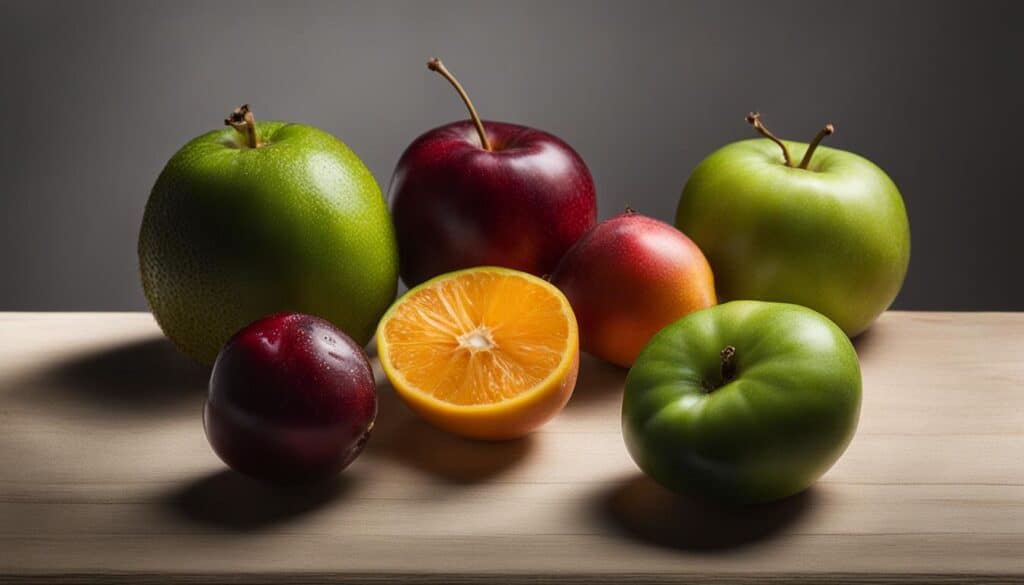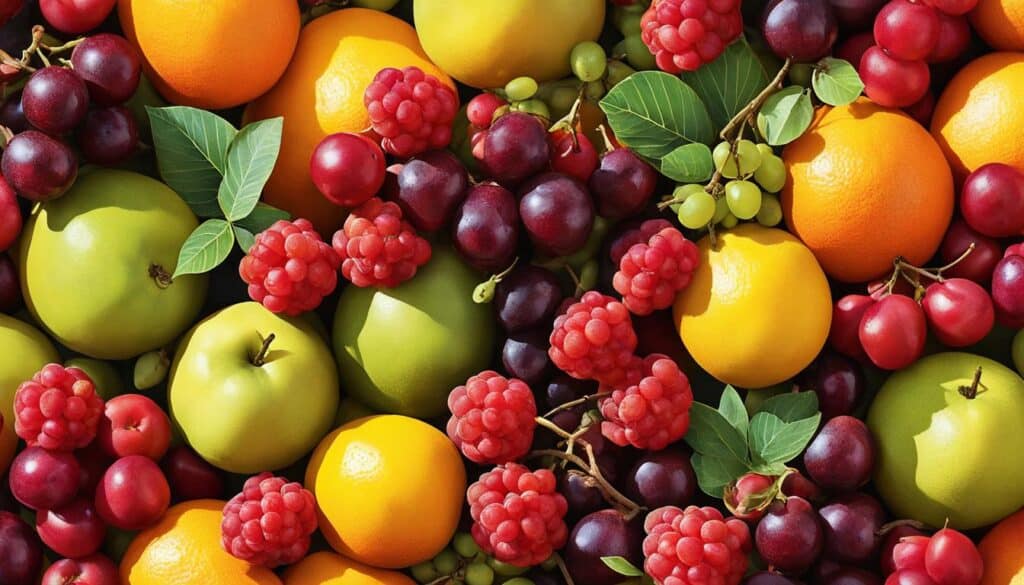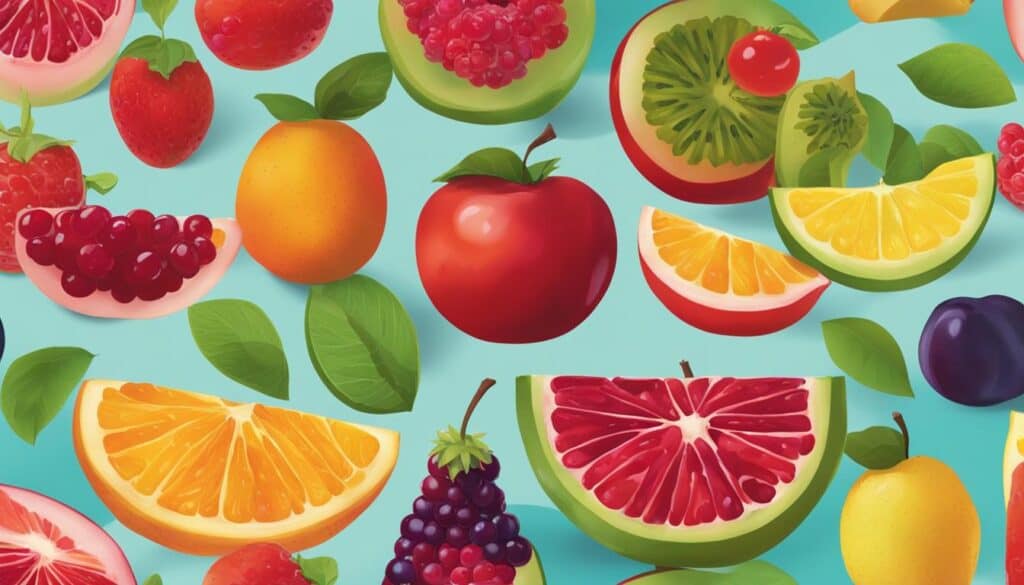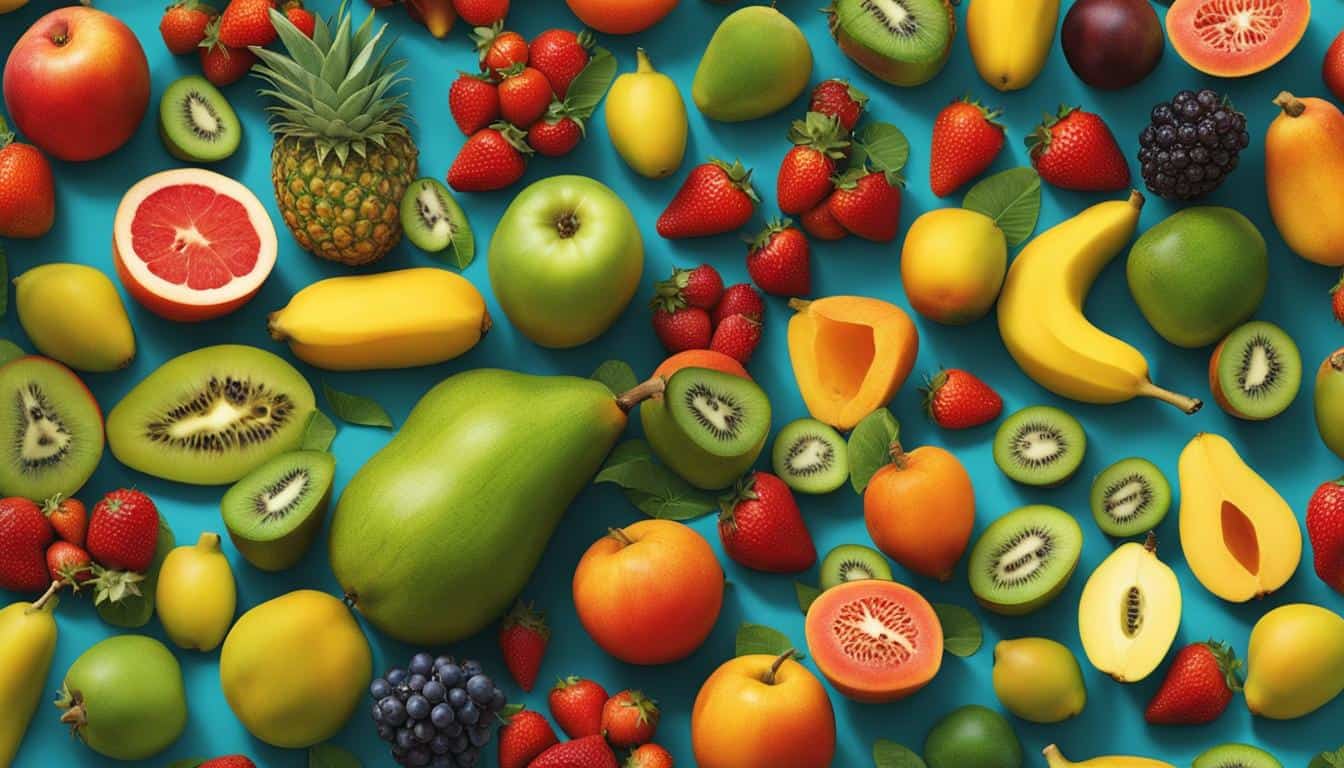Fruit ripening is a fascinating process that involves various physiological and biochemical changes in fruits. But is it considered a chemical change? Let’s explore the ripening process, the role of plant hormones, and the effects of ethylene gas production.
During fruit maturation, hormonal regulation triggers enzymatic reactions that result in the softening of fruit and the accumulation of sugars, giving them their characteristic sweet taste. These changes, including alterations in color and texture, cannot be reversed, making fruit ripening a chemical change.
The key player in fruit ripening is the plant hormone called ethylene. As fruit matures, it produces ethylene gas, which triggers specific enzymatic reactions responsible for various physiological changes.
Key Takeaways:
- Fruit ripening is a chemical change due to the rearrangement of chemical components in fruits.
- Enzymatic reactions and hormonal regulation contribute to the softening, sweetening, and color changes in ripened fruits.
- Ethylene production plays a crucial role in fruit ripening.
- Physiological changes during ripening, including ethylene gas production, are irreversible.
- Understanding fruit ripening helps in controlling the ripening process and extending shelf life.
Physical and Chemical Changes During Fruit Ripening
Fruit ripening is a fascinating natural process that involves a combination of physical and chemical changes. These changes are responsible for the transformation of unripe, firm fruit into mature, flavorful fruit that is ready to be consumed.
One of the physical changes that occur during fruit ripening is an increase in sweetness. This is due to the breakdown of starch into sugars, such as fructose and sucrose. As the fruit ripens, the levels of these sugars rise, resulting in a sweeter taste.
“The accumulation of sugars during fruit ripening contributes to its characteristic sweet flavor.”
In addition to changes in sweetness, the color of the fruit also undergoes a noticeable transformation. Chlorophyll, the pigment responsible for the green color of unripe fruit, is degraded as the fruit ripens. This degradation unveils other pigments, such as carotenoids and anthocyanins, which give fruits vibrant colors ranging from yellow and orange to red and purple.
“The colorful pigments that emerge during fruit ripening add visual appeal and indicate the fruit’s maturity and readiness for consumption.”
The softening of fruit is another significant physical change that occurs during ripening. This change in texture is a result of the breakdown of cell wall components, including cellulose, hemicellulose, and pectin. These structural changes contribute to the fruit’s soft and juicy texture, making it more enjoyable to eat.
“The breakdown of cell wall components leads to the softness of ripe fruit.”
In summary, fruit ripening involves a combination of physical and chemical changes that ultimately contribute to the fruit’s sweetness, coloration, and softness. These changes are driven by specific chemical reactions within the fruit, such as the breakdown of starch into sugars and the degradation of chlorophyll. The breakdown of cell wall components also plays a role in the softening of the fruit. Understanding these processes helps us appreciate the journey from a firm and unripe fruit to a flavorful and enticing one.
| Changes during Fruit Ripening | Effects |
|---|---|
| Increased sweetness | Enhanced flavor |
| Coloration change | Visual appeal and indication of maturity |
| Softness | Pleasant texture and improved eating experience |
Types of Fruits
Fruits can be classified into two main types based on their ripening behavior: climacteric fruits and non-climacteric fruits.
Climacteric fruits continue to ripen after they are harvested, and their ripening is accompanied by an increase in respiration and the production of ethylene gas. Examples of climacteric fruits include bananas, apples, and tomatoes.
Non-climacteric fruits, on the other hand, do not continue to ripen after they are harvested and do not produce significant amounts of ethylene. These fruits are usually harvested when they are already ripe and include fruits like grapes, citrus fruits, and watermelons.
| Climacteric Fruits | Non-Climacteric Fruits |
|---|---|
| Bananas | Grapes |
| Apples | Citrus fruits |
| Tomatoes | Watermelons |
Key Points:
- Fruits can be classified into climacteric and non-climacteric types based on their ripening behavior.
- Climacteric fruits continue to ripen after they are harvested and produce ethylene gas.
- Non-climacteric fruits do not continue to ripen after they are harvested and do not produce significant amounts of ethylene.
- Examples of climacteric fruits include bananas, apples, and tomatoes, while examples of non-climacteric fruits include grapes, citrus fruits, and watermelons.
Ways to Manipulate Fruit Ripening

The food industry has discovered various methods to manipulate fruit ripening to ensure that fruits stay fresh for longer and reach consumers in the desired ripened state. One commonly used approach involves the use of ethylene gas, a natural plant hormone that can be produced commercially. Ethylene gas is utilized to artificially ripen fruits, enhancing and controlling the ripening process.
By regulating the concentration and exposure time of ethylene gas, the ripening process can be efficiently controlled. This enables producers to deliver fruits to the market at the desired stage of ripeness, ensuring optimal flavor, color, and texture. Ethylene gas has become widely accepted as a safe and effective method for fruit ripening manipulation in commercial settings.
While ethylene gas is the primary method for fruit ripening, other compounds like acetylene and ethophon have been used to artificially induce ripening. However, these alternatives may have drawbacks such as toxicity, making ethylene the preferred choice for fruit ripening manipulation in the industry.
| Method | Application | Advantages | Disadvantages |
|---|---|---|---|
| Ethylene Gas | Applied to fruits to enhance ripening process |
|
|
| Acetylene | Artificially induce ripening |
|
|
| Ethephon | Artificially induce ripening |
|
|
Overall, the use of ethylene gas remains the most widely accepted and safe method for fruit ripening manipulation in commercial settings. Its ability to control the ripening process and enhance the desired characteristics of fruits makes it a preferred choice for ensuring high-quality produce reaches consumers.
Regulation of Organic Fruit Ripening

When it comes to organic fruit ripening, there are specific regulations and standards in place to ensure that the process aligns with organic principles. Ethylene gas, a commonly used method for fruit ripening, is allowed in organic fruit production under certain conditions. Let’s take a closer look at the regulations and certification process involved.
Organic Standards for Fruit Ripening
The Code of Federal Regulations and the National Organic Standards Board (NOSB) have established guidelines for the use of ethylene in organic fruit ripening. According to these standards, ethylene can be used for post-harvest ripening of tropical fruits and degreening of citrus fruits in organic production.
“Ethylene can be used for post-harvest ripening of tropical fruits and degreening of citrus fruits in organic production.”
However, it’s important to note that the use of ethylene for ripening organic fruits should be reviewed and approved by a certifying agency. This process ensures that the use of ethylene complies with the organic standards and regulations.
Organic Certification Process
The certification process for organic fruit ripening involves a thorough review of the methods and practices used in the production process. It includes an assessment of the materials, such as ethylene gas, being used and their compliance with organic standards.
Certifying agencies conduct inspections, evaluate documentation, and lab test samples to ensure that the fruits meet the organic standards throughout the ripening process.
Tropical Fruits and Ethylene Use
The definition of “tropical fruits” can vary, and it’s recommended to consult the United States Department of Agriculture (USDA) for guidance on the specific fruits that fall under this category. The USDA provides valuable information on the use of ethylene in organic fruit production.
| Tropical Fruits | Allowed Ethylene Use |
|---|---|
| Bananas | Post-harvest ripening |
| Papayas | Post-harvest ripening |
| Mangoes | Post-harvest ripening |
Effects of Eating Overripe Fruits

When fruits become overripe, they undergo fermentation due to the high concentration of sugars present. This fermentation process leads to the production of ethanol as a byproduct.
While overripe fruits may not be appealing to humans, they can be a source of nourishment for wildlife. Some species of animals, such as birds, bats, and certain primates, are known to feed on overripe fruits and play a role in seed dispersion.
The fermentation process in overripe fruits contributes to the production of ethanol, which can have effects on the behavior and physiology of animals that consume them.
For example, when animals consume overripe fruits, the ethanol produced during fermentation can influence their behavior, leading to signs of intoxication or altered movement patterns. Additionally, the consumption of overripe fruits can affect the digestive system of animals and may result in gastrointestinal disturbances.
Overall, while overripe fruits may not be desirable for human consumption, they serve as an important food source for wildlife and play a role in seed dispersal within ecosystems.
Conclusion

Fruit ripening is an intriguing process that involves a series of physiological and biochemical changes. These changes are classified as a chemical change due to the breaking of chemical bonds and rearrangement of components within the fruit. Ethylene production plays a crucial role in fruit ripening and can be manipulated to control the ripening process artificially. Understanding the different types of fruits, their ripening behavior, and the potential effects of consuming overripe fruits provide valuable insights into the science behind fruit ripening.
Throughout this article, we have explored the various aspects of fruit ripening, including the physiological changes, the production of ethylene, and ways to control the ripening process. The complex nature of fruit ripening highlights the intricate biochemical reactions that occur in fruits as they mature. By harnessing our knowledge of these processes, we can extend the shelf life of fruits and ensure that they reach consumers when they are at their peak ripeness.
Overripe fruits, although unappealing to humans, serve as a vital food source for wildlife. The fermentation process that occurs in overripe fruits leads to the production of ethanol, which can have effects on the behavior and physiology of animals that consume them. This further emphasizes the significance of fruit ripening in the natural ecosystem.
As we continue to explore the science behind fruit ripening, further advancements in our understanding of the chemical changes, physiological processes, and control mechanisms will enhance our ability to manipulate fruit ripening for various purposes. Whether for commercial use or personal consumption, the study of fruit ripening is a captivating field that continues to uncover new insights and possibilities.
Comparison of Climacteric and Non-Climacteric Fruits
| Climacteric Fruits | Non-Climacteric Fruits |
|---|---|
| Bananas | Grapes |
| Apples | Citrus fruits |
| Tomatoes | Watermelons |
References
When exploring the fascinating world of fruit ripening, it’s vital to refer to scientific literature. Here are some valuable references that provide insights into the biochemical and physiological processes involved in fruit ripening, as well as the role of plant hormones, enzymatic reactions, and genetic factors in regulating this process:
- E. Fox, J. Giovannoni, “Comprehensive Biotechnology (Second Edition)”, 2011
- Avtar K. Handa, Autar K. Mattoo, “Plant Biotechnology and Agriculture”, 2012
- Da Cheng Hao, Pei Gen Xiao, “Medicinal Plants”, 2015
- Rupert Fray, Silin Zhong, “Applied Plant Genomics and Biotechnology”, 2015
- Francisca Ortega-García, Juan Peragón, “Olives and Olive Oil in Health and Disease Prevention”, 2010
- Encyclopedia of Food and Health, 2016
These scientific references serve as reliable sources for understanding the intricate details of fruit ripening, the underlying physiological changes, and the chemical mechanisms at play. By consulting these works, you can delve deeper into the fascinating world of fruit ripening.
FAQ
Is fruit ripening a chemical change?
Yes, fruit ripening is considered a chemical change as it involves the breaking of bonds between molecules and the rearrangement of chemical components within the fruit.
What are the physical and chemical changes that occur during fruit ripening?
During fruit ripening, there are physical changes such as an increase in sweetness due to the accumulation of sugars, coloration changes as chlorophyll is degraded and pigments are produced, and softening of the fruit due to the breakdown of cell wall components.
What are the different types of fruits based on ripening behavior?
Fruits can be classified as climacteric or non-climacteric. Climacteric fruits continue to ripen after harvest, while non-climacteric fruits do not ripen after harvest.
How can fruit ripening be manipulated?
The ripening of fruits can be artificially manipulated by using ethylene gas, which can enhance the ripening process. Ethylene concentration and exposure time can be controlled to regulate ripening.
Can ethylene gas be used for organic fruit ripening?
Yes, ethylene gas can be used for post-harvest ripening of tropical fruits and degreening of citrus fruits in organic fruit production, but it should be reviewed by a certifying agency to ensure compliance with organic standards.
What are the effects of consuming overripe fruits?
Overripe fruits undergo fermentation, leading to the production of ethanol. While overripe fruits may not be appealing to humans, they can be a source of nourishment for wildlife species that feed on them.
In summary, what are the key points about fruit ripening?
Fruit ripening involves complex physiological and biochemical changes, is considered a chemical change, is regulated by the production of ethylene, and can be manipulated using ethylene gas. Overripe fruits undergo fermentation and can be eaten by wildlife.
Can you provide references on fruit ripening?
Sure, here are some references you may find helpful:
– E. Fox, J. Giovannoni, “Comprehensive Biotechnology (Second Edition)”, 2011
– Avtar K. Handa, Autar K. Mattoo, “Plant Biotechnology and Agriculture”, 2012
– Da Cheng Hao, Pei Gen Xiao, “Medicinal Plants”, 2015
– Rupert Fray, Silin Zhong, “Applied Plant Genomics and Biotechnology”, 2015
– Francisca Ortega-García, Juan Peragón, “Olives and Olive Oil in Health and Disease Prevention”, 2010
– Encyclopedia of Food and Health, 2016





Leave a Reply